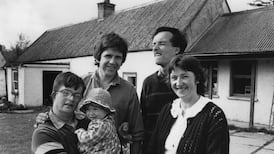The sensory details make the biggest impact when Anthony Goulding, a friendly presence in a flat cap, introduces each school audience to Me, Mollser .
During a recent performance, he tells another group about conditions in 1916 tenement Dublin, the setting for Sean O'Casey's The Plough and the Stars . He describes the stoic fatigue of a lantern lighter in Phoenix Park, a person who kicks his brother out of bed to take his place ("the beds were always warm"), and tells us about the two options for emptying the house's po (chamber pot): carrying it down a cluttered stairs or flinging it out the window.
The audience, high-spirited and a little over-stimulated, erupt in titters. They are a collection of theatre professionals who have convened towards the end of the touring production’s run: eight venues and about 40 national schools.
Me, Mollser is intended for the classroom. The play – the first production from the Abbey Theatre's Priming the Canon series – peers into O'Casey's classic from the perspective of its child character, consumptive 15-year-old Mollser. The idea has two inspirations: Tim Crouch's solo Shakespeare adaptations, such as I, Malvolio and I, Peaseblossom , and the RSC's Shakespeare in Schools programme.
In 2012 the writer and performer Ali White was commissioned to take a similar approach to Mollser, and she began working with the actor Roxanna Nic Liam, then performing the role in Wayne Jordan's production.
They didn’t have much to work with: Mollser has about 12 lines of dialogue in O’Casey’s play. You tend to judge other characters by their relationship to Mollser, such as the tender gestures made by Bessie Burgess, but Mollser is barely there. The strength of White’s play, her first for children, is to imagine another version of Mollser – someone who is both a watcher and a doer – and in Mary-Lou McCarthy’s spirited performance, the character gets a new lease of life.
She appears, with a start, from under a sheet among boxes that conjure up a cramped tenement space. Never mind who she is – who are we, this flinty girl in a nightdress wants to know: the British Army? Irish Volunteers? Ghosts?
On a bright morning in a classroom in the North Bay Educate Together National School, an audience of attentive fifth-class students answer each of her questions politely. White’s script has contingency plans in the event that more exuberant students do claim to be ghosts (“So you can walk through walls then, can you?”) but here McCarthy never requires them.
The performance anticipates disbelief, spelling out tenement conditions in persuasive images: a child without shoes; a hundred people living in the same house; stray bullets of the Easter Rising whizzing through windows; or the exploratory swirl and sniff that Mollser gives her po (which raises a laugh from adults in two performances I attend, and none from the children). But the experience of the performers is that children may be better informed than anticipated. One boy, recalling the stories of his grandmother, adds a further detail: you kicked the back door of the house three times before opening it to shoo the rats away.
In a neat and involving device, Mollser refers to other characters with metonymic props that her audience get to handle – a ruler for the carpenter Fluther Good, a book of Protestant hymns for the loyalist Bessie Burgess – and later represents one clash of ideals as the amusing quarrel between a white feather (for the befuddled nationalist Peter Flynn) and a red tie (for the blowhard communist Young Covey). But Mollser also gets a sense of agency; her reported journey through Dublin, which McCarthy gives a wicked tomboy humour, or moments of feminine fantasy for a husband like Jack Clithero, suggest the life she ought to have had. After all these years, Molly Gogan finally leaves home.
Demystifying the classics
The aim of
Priming the Canon
, as the Abbey's Phil Kingston explains, is to demystify the classics for children who will later study them in secondary school, but he is also aware that a child's first contact with drama is influential and better served in a familiar place. If you want children to come to the theatre, the theatre must first come to them. The next play in the series will be
Me, Michael
, for which Tara McKevitt is giving another voice to the child/narrator in Brian Friel's
Dancing at Lughnasa
. After that, young characters in Irish classics are thin on the ground.
It's heartening to hear a young audience interpret a performance on a detailed and imaginative level. But another influence of Me, Mollser , evident in the post-performance workshop, is to encourage children to engage with the politics that affect Mollser and themselves. What rights were denied to Mollser, they are asked? They quickly answer, in groups, with something like the tenets of the UN Convention on the Rights of the Child: the right to healthcare, to a safe home, to an education, to shoes.
This Mollser had been originally conceived as a character whose age made her relatable to a young audience. But the performance made her something more whole: not a tragedy, a peripheral character or even a ghost, but an individual.
Before the show, McCarthy puts her stage in order, cues her music and runs through vocal exercises. She hears footsteps coming down the corridor; a new audience. “That’s me,” she says, and disappears.












